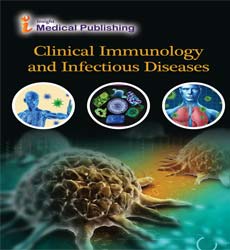Impact of Immunodeficiency on Susceptibility to Bacterial and Viral Infections
Mickle Horner*
Department of Microbiology, Makerere University College of Health Sciences, Kampala, Uganda
*Corresponding author
Mickle Horner, Department of Microbiology, Makerere University College of Health Sciences, Kampala, Uganda, E-mail: mickle@horner.ug
Received date: January 01, 2025, Manuscript No. Ipciid-25-20579; Editor assigned date: January 03, 2025, PreQC No. Ipciid-25-20579 (PQ); Reviewed date: January 15, 2025, QC No. Ipciid-25-20579; Revised date: January 22, 2025, Manuscript No. Ipciid-25-20579 (R); Published date: January 28, 2025, DOI: 10.36648/.9.1.4
Citation: Horner M (2025) Impact of Immunodeficiency on Susceptibility to Bacterial and Viral Infections. Clin Immunol Infect Dis Vol.9 No.1:4
Introduction
Immunodeficiency, whether primary or secondary (acquired through conditions such as HIV infection, chemotherapy, or malnutrition), profoundly increases susceptibility to bacterial and viral infections by disrupting the bodyâ??s ability to mount effective immune responses. The type and extent of immune dysfunction affecting innate, humoral, or cellular components determine which pathogens dominate, how infections progress, and what complications arise, making immunodeficiency a key determinant of infectious disease burden and clinical outcome [1].Description
Innate immune defects, including impairments in neutrophil function, complement pathways, or Toll-like receptor signaling, compromise the first line of defense against bacteria and viruses. For example, neutropenia predisposes individuals to recurrent bacterial infections such as pneumonia, sepsis, and skin abscesses, while complement deficiencies increase vulnerability to encapsulated organisms like Neisseria meningitides. Similarly, defects in type I interferon signaling impair antiviral defenses, allowing unchecked replication of viruses such as influenza, herpes viruses, and respiratory pathogens. Thus, innate immune deficiencies often manifest as frequent, severe, or unusual infections early in the disease course [2]. Humoral immunodeficiencies, such as Common Variable Immunodeficiency (CVID) or selective IgA deficiency, primarily predispose individuals to recurrent bacterial infections of the respiratory and gastrointestinal tracts, including Streptococcus pneumonia and hemophilic influenzae. The lack of neutralizing antibodies also weakens protection against viral reinfection, although some T-cell function may compensate partially on the other hand, cellular immunodeficienciesâ??such as those caused by HIV infection Severe Combined Immunodeficiency (SCID), or immunosuppressive therapies [3]. Epsteinâ??Barr virus, and respiratory viruses, as well as intracellular bacteria and opportunistic organisms. The spectrum of infections reflects the central role of T cells in orchestrating both antiviral and antibacterial defenses Secondary immunodeficiencies, the most common globally, highlight the interplay between environment, treatment, and immunity. HIV-induced CD4 T-cell depletion, for instance, underpins susceptibility to tuberculosis, bacterial sepsis, and chronic viral reactivations [4] Hile chemotherapy-induced bone marrow suppression predisposes patients to neutropenic sepsis and viral reactivations like herpes zoster Malnutrition and chronic illnesses further weaken immunity, creating overlapping vulnerabilities. Clinically, immunodeficiency not only increases infection risk but also alters disease presentation, often blunting classic inflammatory signs and leading to diagnostic delays. although some T-cell function may compensate partially The lack of neutralizing antibodies also weakens protection against viral reinfection, Preventive strategiesâ??vaccination, antimicrobial prophylaxis, immunoglobulin replacement, and immune reconstitution therapiesâ??remain essential to reduce morbidity and mortality in these patients [5].Conclusion
In summary, immunodeficiency profoundly heightens susceptibility to bacterial and viral infections by disrupting innate and adaptive immune defenses, shaping both the frequency and severity of disease. The type of immune defect determines the infectious profile, with humoral deficiencies predisposing to bacterial infections and cellular defects leaving individuals vulnerable to viral and opportunistic pathogens. Recognizing these vulnerabilities is critical for timely diagnosis, targeted prevention, and tailored therapy, ultimately improving outcomes in immune compromised populations. h4>Acknowledgement None.Conflict of Interest
None. References- Claytor B, Polston D, Li Y (2025) Multifocal Motor Neuropathy: A Narrative Review. Muscle Nerve 71: 512–534
Google Scholar Cross Ref Indexed at
- Van den Bergh PYK, Hadden RDM, Bouche P, Cornblath DR, Hahn A, et al. (2010) European Federation of Neurological Societies/Peripheral Nerve Society Guideline on Management of Chronic Inflammatory Demyelinating Polyradiculoneuropathy: Report of a Joint Task Force of the European Federation of Neurological Societies and the Peripheral Nerve Society—First Revision. Eur J Neurol 17: 356–363
Google Scholar Cross Ref Indexed at
- Deepak P, Kim W, Paley MA, Yang M, Carvidi AB, et al. (2021) Effect of Immunosuppression on the Immunogenicity of mRNA Vaccines to SARS-CoV-2: A Prospective Cohort Study. Ann Intern Med 174: 1572–1585
Google Scholar Cross Ref Indexed at
- Ferri C, Ursini F, Gragnani L, Raimondo V, Giuggioli D, et al. (2021) Impaired Immunogenicity to COVID-19 Vaccines in Autoimmune Systemic Diseases: High Prevalence of Non-Response in Different Patients’ Subgroups. J Autoimmun 125: 102744
Google Scholar Cross Ref Indexed at
- Holm-Yildiz S, Dysgaard T, Krag T, Pedersen BS, Hamm SR, et al. (2023) Humoral Immune Response to COVID-19 Vaccine in Patients with Myasthenia Gravis. J Neuroimmunol 384: 578215
Google Scholar Cross Ref Indexed at
Open Access Journals
- Aquaculture & Veterinary Science
- Chemistry & Chemical Sciences
- Clinical Sciences
- Engineering
- General Science
- Genetics & Molecular Biology
- Health Care & Nursing
- Immunology & Microbiology
- Materials Science
- Mathematics & Physics
- Medical Sciences
- Neurology & Psychiatry
- Oncology & Cancer Science
- Pharmaceutical Sciences
